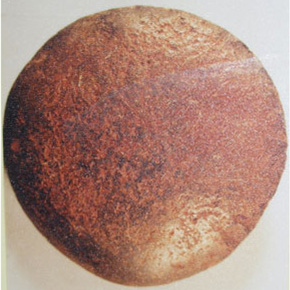Panel 2 – Local Ancestors
“in keeping with a cultural tradition common to all Aboriginal people we acknowledge and respect the culture and traditions of this area before European invasion.”
It is not the purpose of this exhibition to go too much into the way of life of the Aborigines in the western region of Melbourne in the early days. That information can be found in other resources. We should say however that the life and cultures of Aboriginal tribes and clans was quite varied and as different from each other as European countries see their cultures as different from each other. The culture of the Aborigines of this part of Victoria was unlove in its language and customs.
“First creation had a dream
who then told all the other animals
who told each other
they then sang the dream
finally the world was created.”
“…Or perhaps the dream was creation…”
“All the Aboriginal world was created by dreaming figures who are represented by animals, birds, fish and reptiles.”
“These are some of our worlds, our cultures and our histories where we came from. The people from this area were a part of the Kulin nation…”
This map shows that some Aboriginal names live on and where they have been appropriated by white man.
Note: There are often different versions of spelling Aboriginal tribes, clans, place names and words generally. There was no Aboriginal written language and the different versions of spelling arose from a variety of attempts to interpret the sounds of Aboriginal languages with English vowels and consonants. Naturally this has led to a certain amount of confussion in records of names.
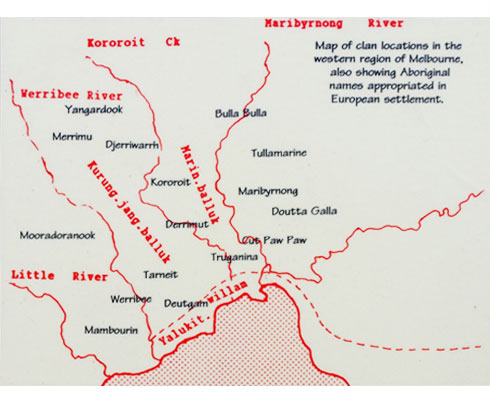
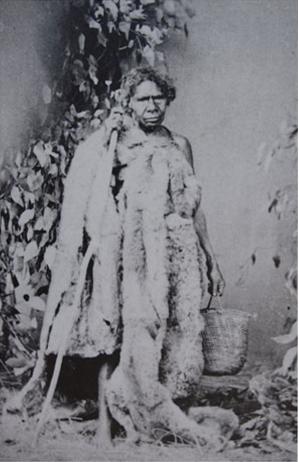
The origins of this photograph remain unknown.
It was acquired by th La Trobe Library in the 1930s and almost certainly depicts a Victorian Aboriginal woman. Although posed, the photograph shows excellent details oof a traditional possum skin cloak and basketry. This woman holds a digging stick, which would have been her most valuable and usefgul possession.
Photograph courtesy of Image Library, State Library of New South Wales; information courtesy, Readings in Victorian Prehistory (Volume 2), by P. J. F. Coutts.
* THE CREATION OF FIRE * (Melbourne story)
A long time passed but there were no fires. The population grew, but it was extremely cold and they ate raw flesh – and all were very uncomfortable.
One day the females with their digging sticks {kannan) were digging murrars – ante eggs, when several snakes came from out of the ground, where the women were digging. They became frightened and began beating
the snakes, but the reptiles would not die.
Karakarook appeared with two men, Tourt and Tarrer, and for a long time the baqrook and the kulin fought the snakes, when suddenly Karakarook’s digging stick became splintered and smoke and sparks came from its tip. It was fire.
The next instant, Waang – the Crow – swooped down from the heavens and stole the fire. Tourt and Tarrer flew off in pursuit of the villain. The Crow journeyed to Nun-nur-woon – the mountainous region which is
now called Wilson’s Promontory, where Tourt and Tarrer regained the fire from the Crow. It was Tarrer who returned the fire safely, and preserved it by breaking off strips of bark to keep it from going out. Sadly, Tourt
died on a mountain called Munnio, after he’d tried, unsuccessfully, to stop the flames from being extinguished.
Bundjel was so pleased with Tarrer and the spirit of Tourt, that he bestowed a sacred honour on both men by turning them into two stars which shone fiercely like a fire. This is the explanation of the two stars now Identified as Pollux and Castor.
Karakarook showed the bagrook the fire-sticks and told them that they would never be without fire again.
The people with the use of fire were now Marnumuk, “comfortable”, and the population grew.
This story has been re-told here by Robert Mate-Mate.
Bun Jil
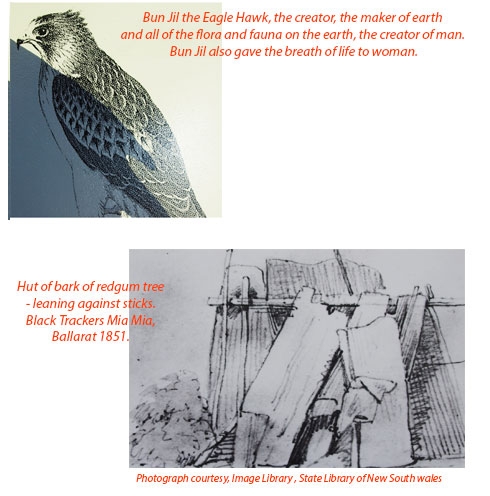
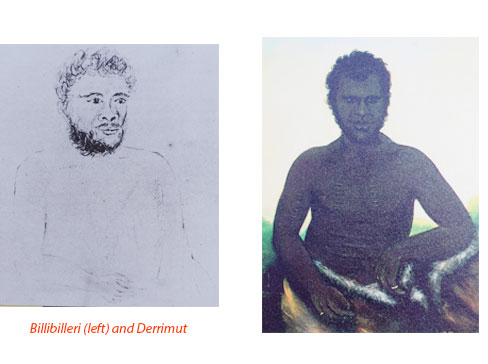
“Billibilleri and Derrimut are two of the local ancestors that were here at the beginning of the white man’s history in this region. They had a way ofliving that was different to and possibly much older than European history.”
Billibilleri
Billibilleri was born about 1791 and died on August 10th 1846. He was a leader of the Gunung-Willam-Balluk clan of the Woiworung tribe and his family owned the rights to quarry a particular stone from Mt. William, near Lancefield, that was traded throughout Victoria and far into New South Wales. He was a stone axe maker and trader. Billibilleri, known as Jacky Jacky to the Europeans, was a powerful figure in his day and was said to be a signatory to the ‘Batman Treaty’. Many of Billibilleri’s descendants live and work in Melbourne today.
Derrimut
Courtesy: State Library Picture Collection N.S.W.
Derrimut of the Bunurong was commemorated by the early settlers of Melbourne for saving them from a planned attack and massacre by the Woiworung by informing them through a young member of the European party, who he befriended, of the impending attack.
Stone
An important feature of this region was a particular type of stone from what is now called Mt William about twenty kilometres north of the township of Bulla which was used for trade through central and west Victoria all the way up to the Darling River in New South Wales.
An Aboriginal person can relate to their tribal homeland through a type of stone. For example, stories have been kept and told in traditional oral history form about the diorite stone of Mount William.
